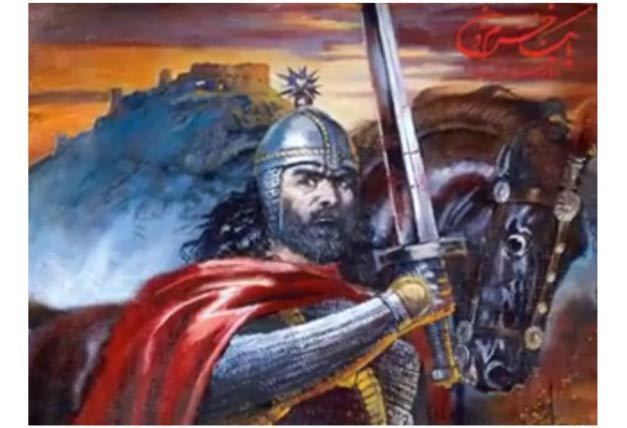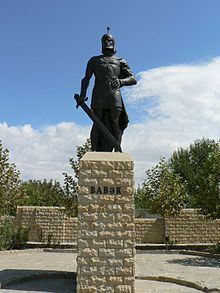Native name پاپک خرمدین Ethnicity Persian Name Babak Khorramdin | Years active 23 Role Political activist | |
 | ||
Known for Leader of the Khorram-Dinan Spouse Banu Khorramdin (m. ?–838 AD) Parents Abd-Allah Khorramdin, Mahru Similar Al Mansur, Abu Muslim, Abu Muslim al Khawlani | ||
Babak Khorramdin - Clip Epic Aggressive Music
Babak the hero
Bābak Khorramdin (Formally known as "Pāpak" meaning "Young Father") (Persian: بابک خرمدین, alternative spelling: Pāpak Khorramdin; 795, according to some other sources 798— January 838) was one of the main Persian revolutionary leaders of the Iranian Khorram-Dinān ("Those of the joyous religion"), which was a local freedom movement fighting the Abbasid Caliphate. Khorramdin appears to be a compound analogous to dorustdin "orthodoxy" and Behdin "Good Religion" (Zoroastrianism), and are considered an offshoot of neo-Mazdakism. Babak's Iranianizing rebellion, from its base in Azerbaijan in northwestern Iran, called for a return of the political glories of the Iranian past. The Khorramdin rebellion of Babak spread to the Western and Central parts of Iran and lasted more than twenty years before it was defeated when Babak was betrayed. Babak's uprising showed the continuing strength in Azerbaijan of ancestral Iranian local feelings.
Contents
- Babak Khorramdin Clip Epic Aggressive Music
- Babak the hero
- Etymology
- Early life
- Movement
- Death
- Legacy
- References

Etymology
Babak (Persian: بابک) is a given name for Iranian males It is Arabicized for Pāpak which means "young father" in Middle Persian.
Early life

Bābak was born into a Persian family in Adharbayjan (northwestern Iran) close to the city of Artawila (modern Ardabil). According to Wāqid ibn 'Amr Tamimi, the oldest biographer on Babak, Bābak's father was a Persian cooking-oil vendor from Ctesiphon, capital of the Sasanian Empire (modern al-Mada'in, 35 km south of Baghdad in Iraq) who left for the Adharbayjani frontier zone and settled in the village of Balālābād in the Maymadh district. According to Fasīh, his mother – a native Persian of Adharbayjan – was known as Māhrū Moon-Face/Belle.

After his father's death in his early teens, Babak was given the responsibility of his two brothers and mother during a Zoroastrian ceremony in a fire temple. By the age of 18, Bābak had established himself in the city of Tabriz and was engaged in the arms trade and industry. He also served a certain Muhammad ibn Rawwad Azdi. Later on, this engagement gave him the opportunity to travel to some regions and become familiar with regions like the Caucasus, the Middle East, and the Byzantine Empire.
Movement

In 755, Abu Muslim was murdered. Although he had helped the Abbasids to defeat the former Caliphs, the Umayyad dynasty, the ruling Caliph had given the order to kill him, probably because of his increasing popularity among Iranians and Non-Muslims. Many Iranians, who had expected more freedom and more rights from the new rulers, could not believe that their hero was killed by the ruling Caliph whom they had considered a friend of Iran and Iranians.

This incident led to many revolts, mostly by angry Zoroastrians. This, in turn, forced the Caliphs to use more violence against the Iranian population in order to keep the eastern provinces under control. The constant revolts did not come to an end in the following decades, and the Iranian population of the Caliphate was constantly being oppressed.
Babak joined the Khurramiyyah (Khorram-Dinān) where he met his wife and battle companion, Banu Khorramdin. The story of joining the Khorrami movement is being told in Waqed's account, in summary, as follows:
Under the direction of his mentor Javidan Shahrak, a leader of one of the sects of the Khorramdin, Babak's knowledge of history, geography, and the latest battle tactics strengthened his position as a favorite candidate for commander during the early wars against the Arab occupiers.
Bābak was a highly spiritual person who respected his Zoroastrian heritage. He made every possible effort to bring Iranians together and also with leaders such as Maziar to form a united front against the Arab Caliph. According to the medieval historian, Ibn Esfandyar, who composed the book Tarikh-e Tabaristan "History of Tabaristan", Maziar said:
However, one of the most dramatic periods in the history of Iran was set under Bābak's leadership between 816–837. During these most crucial years, they not only fought against the Caliphate, but also for the preservation of Persian language and culture.
After the death of Javidan, Babak married Javidan's wife and became the Khorramis' leader, sometime in the year 816-17 during al-Ma'mun's reign. Babak incited his followers to rise in rebellion against the caliphal regime. The reports state that Babak called Persians to arms, seized castles and strong points, thereby barring roads to his enemies. Gradually a large multitude joined him.
According to Vladimir Minorsky, around the 9th–10th century:
There had long been groups of Khorramis scattered in Isfahan, Adharbayjan, Ray, Hamadan, Armenia, Gorgan, and elsewhere in Iran, and there had been some earlier Khorrami revolts, e.g., in Gorgan jointly with Red Banner (Sorkh-'alamān) Bātenis in the caliph Al-Mahdi's reign in 778-79, when 'Amr b. 'Ala', the governor of Tabarestān, was ordered to repulse them, and at Isfahan, Ray, Hamadan, and elsewhere in Harun al-Rashid's realm, when 'Abd-Allah b. Malek and Abu Dolaf 'Ejli put them down on caliph's behalf – but none had the scale and duration of Babak's revolt, which pinned down caliphal armies for twenty years. After Babak's emergence, the Khorrami movement was centered in Adharbayjan and reinforced with volunteers from elsewhere, probably including descendants of Abu Muslim's supporters and other Iranian enemies of the 'Abbasid caliphate. The figures given for the strength of Babak's Khorramdinan army, such as 100,000 men (Abu'l-Ma'ali), 200,000 (Mas'udi), or innumerable (Baghdadi) are doubtless highly exaggerated but at least indicate that it was large. At that time of Babak, there were Khorramis scattered in many regions of Iran, besides Adharbayjan, reportedly in Tabarestan, Khorasan, Balkh, Isfahan, Kashan, Qom, Ray, Karaj, Hamadan, Lorestan, Khuzestan as well as in Basra, and Armenia.
Tabari records that Babak claimed he possessed Javadan's spirit and that Babak became active in 816–817. In 819–820 Yahya ibn Mu'adh fought against Babak, but could not defeat him. Two years later Babak vanquished the forces of Isa ibn Muhammad ibn Abi Khalid. In 824–825 the caliphal general Ahmad ibn al Junayd was sent against Babak. Babak defeated and captured him.
In 827–828 Muhammad ibn Humayd Tusi was dispatched to fight Babak. He won a victory and sent some captured enemy, but not Babak, to al-Ma'mun. However, about two years later, on June 9, 829, Babak won a decisive victory over this general at Hashtadsar. Muhammad ibn Humayd lost his life. Many of his soldiers were killed. The survivors fled in disarray.
In 835–836 the caliph al-Mu'tasim sent his outstanding general Afshin against Babak. Afshin rebuilt fortresses. He employed a relay system to protect supply caravans. Babak tried to capture the money being sent to pay Afshin's army, but was himself surprised, lost many men and barely escaped. He did succeed in capturing some supplies and inflicting some hardship on his enemies. Amongst Babak's commander, various names have been mentioned including Azin, Rostam, Tarkhan, Mua’wiyah and Abdullah.
The next year Babak routed the forces of Afshin's subordinate, Bugha al-Kabir. In 837–838 al-Mu'tasim reinforced Afshin and provided him clear military instructions. Patiently following these enabled Afshin to capture Babak's stronghold of Badhdh. Babak escaped. Al-Mu'tasim sent a safety guarantee for Babak to Afshin. This was taken to Babak who was very displeased. He said:
"Better to live for just a single day as a ruler than to live for forty years as an abject slave."
He decided to leave the country for the Byzantine Empire and on his way Babak met Sahl Smbatean (Sahl ibn Sunbat in Arab sources), Prince of Khachen, who was Armenian due to the Armenian historiography and Caucasian Albanian due to the Adharbayjani historiography. Sahl Smbatian, however, handed Babak over to Afshin in return for a large reward. Al-Mu'tasim commanded his general to bring Babak to him. Afshin informed Babak of this and told him since Babak might never return, this was the time to take a last look around. At Babak's request, Afshin allowed his prisoner to go to Badhdh. There Babak walked through his ruined stronghold one night until dawn.
Eventually, Bābak, his wife, and his warriors were forced to leave Ghaleye Bābak after 23 years of constant campaigns.
Death
He was eventually betrayed by Afshin and was handed over to the Abbasid Caliph. During Bābak's execution, the Caliph's henchmen first cut off his legs and hands in order to convey the most devastating message to his followers. The legend says that Bābak bravely rinsed his face with the drained blood pouring out of his cuts, thus depriving the Caliph and the rest of the Abbasid army from seeing his pale face, a result of the heavy loss of blood. He was then gibbeted alive whilst sewn into a cow's skin with the horns at ear level to gradually crush his head as it dried out.
Legacy
Babak Khorramdin was not well known outside academia until the 20th century; however, due to Soviet nation building efforts and Babak's following of teaching of Mazdak with its pseudo-communist and socialist themes, Babak Khorramdin was proclaimed a national hero in the Azerbaijan Soviet Socialist Republic. For example, the Soviet era scholar Ziya Bunyadov, claimed that "Babak was a national hero of Azerbaijani people" while the Russian ethnologist, historian and anthropologist Victor Schnirelmann dismisses Bunyadov's theory, criticizing Bunyadov for not mentioning that Babak spoke Persian, and ignoring the witness accounts of Babak's contemporaries who call him Persian. To this day, in the modern Republic of Azerbaijan, Babak is a cult figure and celebrated as a national hero. In modern Iran, due to the rise of nationalism in the 20th century, and renewed interest in pre-Islamic Iran, Babak Khorramdin was rediscovered during the reign of Reza Shah, and is celebrated as a national hero. However, Babak remains a controversial figure in the Islamic Republic, whose idolization is criticized by some Shia clerics.
